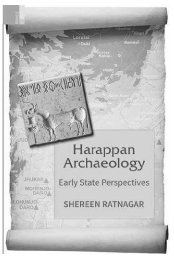An enormous amount of scholarly writing exists on the Harappan civilization. Shereen Ratnagar herself has produced a number of important books on the subject. So why another one? For one thing, the information on South Asia’s oldest civilization continues to grow steadily, and new evidence requires rethinking. Further, as Ratnagar tells us in the Preface, it is time ‘to put the pieces together and to conceive of the entirety of Harappan archaeological remains in terms of a mode of cultural organization, a kind of society, and a set of economic patterns, thereby putting some flesh on the bones.’ Ratnagar’s is not a routine overview. Apart from rich empirical detail, a lively critical perspective runs through the book, one which reflects on archaeological method and interpretation in order to question several hypotheses and stereotypes, not only about the Harappan civilization, but also about the larger Indian past.
The first part of the book focuses on the backbone of the civilization—agriculture and water. There is a detailed discussion of the ‘dynamic landscape,’ drawing on studies that have detailed shifting river courses and coastlines. But Ratnagar argues that there has been too much focus on riverine floods and rainfall in discussions of Harappan agriculture, and that ground water resources were much more important. She also looks at subsistence activities based on animals and marine life, and extends her discussion to the symbolic and religious spheres, for instance in an excursus on the buffalo and the ‘horned deity’ on the so-called Pashupati seal.

